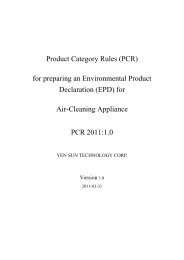Download(PDF) - PCR Library
Download(PDF) - PCR Library
Download(PDF) - PCR Library
Create successful ePaper yourself
Turn your PDF publications into a flip-book with our unique Google optimized e-Paper software.
12 Items applied secondary<br />
data<br />
13 Communication requirements<br />
facilities, recycling processing) of used containers/packaging readying<br />
for recycling in the container/packaging raw material acquisition stage.<br />
b) In the case of aluminum can<br />
Conforming to Annex D, and assuming that aluminum can is recycled to<br />
primary aluminum, include the GHG emissions of transport and the<br />
subsequent processes (transport from intermediate treatment facilities,<br />
recycling processing) of used containers/packaging readying for<br />
recycling in the container/packaging raw material acquisition stage.<br />
[Waste treatment scenario for plastic or paper accessories]<br />
(1) In order to avoid undervaluation, assume that all “plastic or paper<br />
accessories” are incinerated. GHG emissions associated with transport of<br />
these items to incinerate disposal facilities may be calculated based on the<br />
following scenario:<br />
- Means: 2-ton truck (light oil),<br />
- Distance: 50 km (assumed as within a city);<br />
- Loading ratio: 25%<br />
(2) If the data in "general waste incineration (excluding CO2 from waste)"<br />
specified in the GHG Emission Common Factor Database is used as<br />
secondary data, GHG emissions derived from the carbon contained in plastic<br />
wastes shall be separately calculated and included.<br />
[Open-loop recycling]<br />
Process related to transport from intermediate treatment facilities, and process<br />
related to recycling process, for the “used metallic containers/packaging”, and for<br />
“die-cutting scrap metals” from the “containers/packaging production stage”.<br />
(1) Data collection items<br />
Data listed in [Calculating direct impact of recycling] (1) a), b), d) and e), and<br />
following data shall be collected<br />
- Input ratios of “used metallic containers/packaging” and “die-cutting<br />
scrap metals from the containers/packaging production stage” to a<br />
furnace other than converter furnace (in the case of steel can), or the<br />
ratios other than can-to-can ratio (in the case of aluminum can)<br />
- Allocation factor of substitutes (GHG emissions associated with<br />
production of a crude steel or new metal substitute)<br />
(2) Scenarios<br />
When it is difficult to collect primary data, the following scenarios may be<br />
used:<br />
a) In the case of steel can<br />
Conforming to Annex C, and assuming that steel can is recycled into<br />
crude steel substitute, include GHG emissions of transport and the<br />
subsequent processes (transport from intermediate treatment facilities<br />
and recycling) of used containers/packaging readying for recycling as<br />
"recycling effect."<br />
b) In the case of aluminum can<br />
Conforming to Annex D, and assuming that aluminum can is recycled<br />
into new metal substitute, include GHG emissions of transport and the<br />
subsequent processes (transport from intermediate treatment facilities<br />
and recycling) of used containers/packaging readying for recycling as<br />
"recycling effect".<br />
- For emission factor, use the data provided in the “Tentative Database of GHG<br />
Emission Factors for the CFP Pilot Project”.<br />
- Of secondary data which is not included in the Database, the data will be<br />
prepared as “reference data” by the CFP Pilot Project Secretariat.<br />
- For foreign country data, use its country emission factor. If it does not exist,<br />
domestic secondary data may be used with its reason.<br />
-11-















